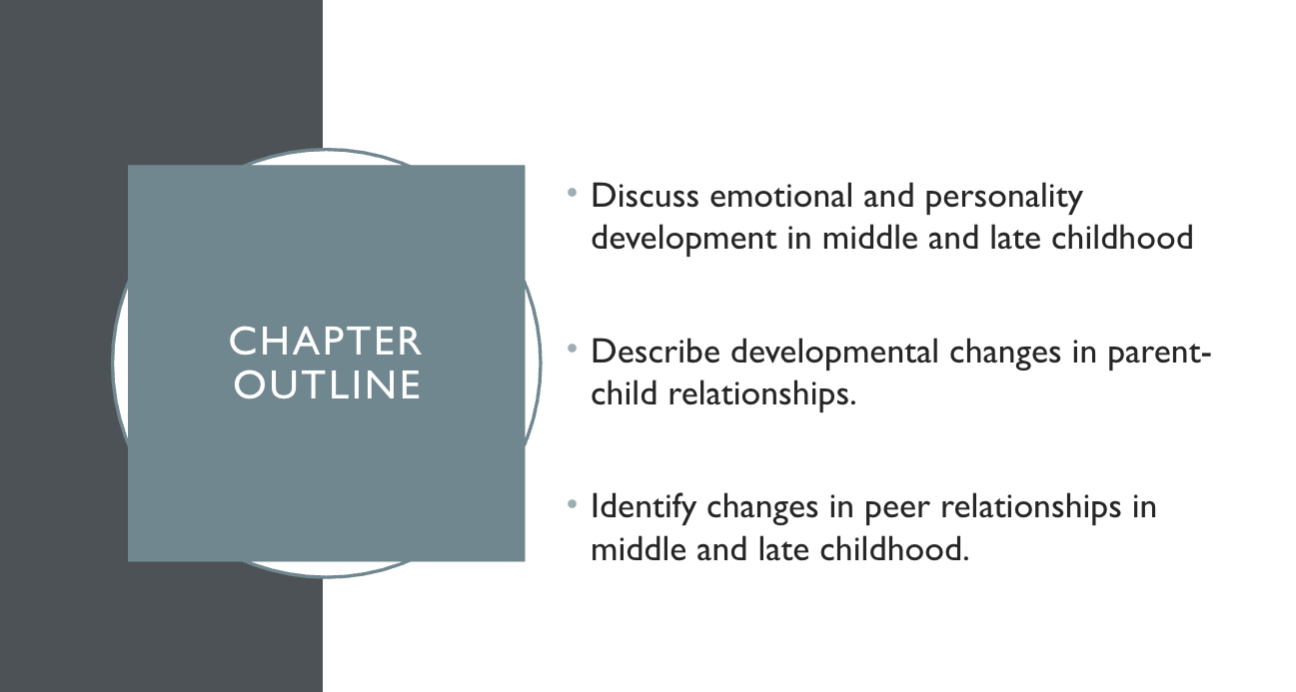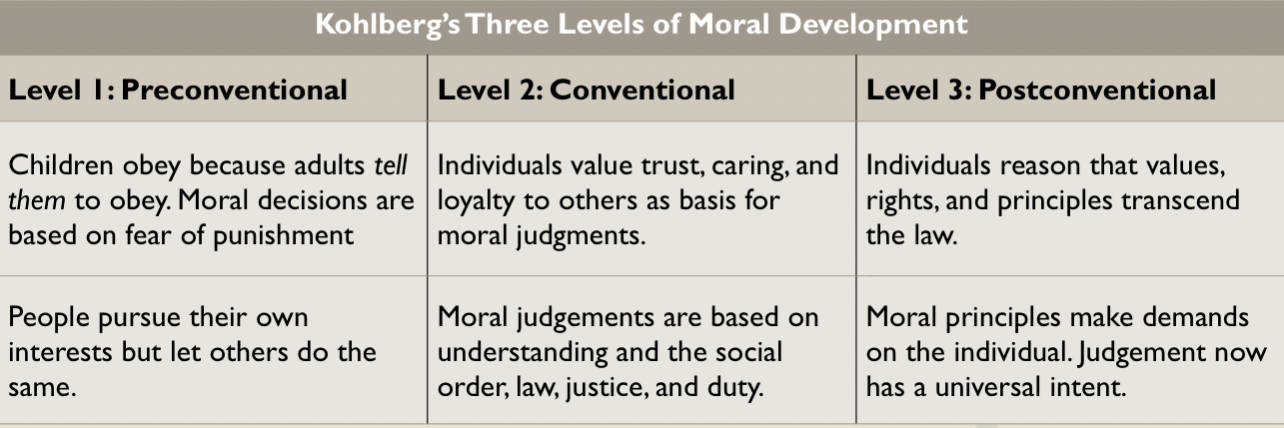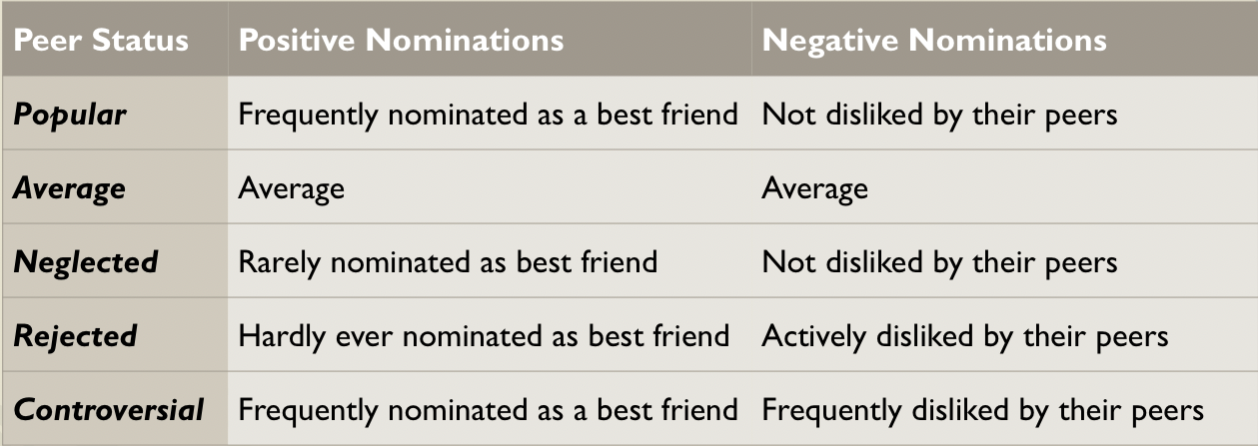Chapter 10

The self
Erikson’s 4th psychosiocial stage of development is industry vs inferiority
Occurs in ages 5-13 years
Children attempt to find the virtue of competence
They may develop self-confidence in abilities when competent and a sense of inferiority when not
There is a lot of social comparison at this stage
Self-Understanding
Self-understanding becomes more complex at this stage
Children describe themselves in terms of psychological characteristics and traits
Older children are more likely to describe themselves as adjectives such as “I am… popular, nice, helpful, mean, smart, and dumb.”
They’re also more likely to recognize social aspects of the self
E.g. referring to themselves as a Girl Scout, or a Dustdevil [member of a sports team].
Children now think about what they can do in comparison with others
Understanding Others
There is an increased capacity for perspective thinking - envisioning another person’s perspective and understanding their thoughts and feelings
It is especially important in determining whether children develop prosocial or antisocial attitudes and behaviors
Prosocial - are more likely to understand and sympathize with others when they are distressed or in need
Antisocial - are more likely to have difficulty in peer relations, to engage in more aggressive and oppositional behavior, and to be reluctant to give to others
Self-Concept
Self-concept - an organized collection of beliefs about the self
These beliefs are also called self-schemas and include personality traits, abilities, physical features, values, goals, & social roles
Self-concepts are domain-specific evaluations
Child, sibling, friend, student, athlete, etc
Self-Esteem
one of the functions of self-concepts is to evaluate the self. The result of this evaluation is termed self-esteem.
Self-esteem refers to one’s overall assessment of one’s worth as a person
Refers to a global self-evaluation that does not always match reality
High: confident, take credit for their success, seek venues to demonstrate their skills, less discouraged by failures (tend to show initiative to keep practicing); self-concept is more stable
Low: confused and more tentative, experience emotional highs and lows; slef-concept is less clear and more susceptible to fluctuations
The belief that one can master a situation and produce favorable outcomes iss called self-efficacy.
Emotional development
the things
Improved emotional udnerstanding
Increased understanding that more than one emotion can be experiences in a particular situation (e.g., bittersweet, happiness, anxiety)
Increased awareness of the events leading to emotional reactions
Capacity for genuine empathy
Use of self-strategies for redirecting feelings
Emotional regulation is characterized by deliberate efforts to manage one’s behaviors, emotions, and thoughts.
Moral Development
older children have autonomous morality; they consider the intentions of individuals, believe rules are subject to change, and are aware that punishment does not always follow wrongdoing.

Moral personality
Moral personality - a pattern of moral characteristics that is distinctively one’s own
People with moral identity construct the self with reference to moral categories
Violating moral commitment places their integrity at risk
People with moral character have the willpower, desire, and integrity to stand up to pressure and overcome distractions
They display honesty, truthfulness, trustworthiness, compassion, dependability, loyalty, and conscientiousness.
Gender in Context
gender stereotypes are broad categories that reflect general impressions and beliefs about males and females
Masculine traits: risk taker, dominant, aggressive, forceful, outspoken
Feminine traits: affectionate, understanding, gentle, reserved
The traits people display may vary with the situation; the nature and extent of gender differences may depend on context
Example helping behavior
Women are more likely to volunteer their time to help a child with a personal problem or engage in caregiving behavior
Men are more likely to help if the situation poses a sense of competence or involves danger (helping a person stranded by the roadside in the middle of the night).
Parent-child relationships
At this stage…
Parents spend less time with children
Parents influence in-school achievement and children’s participation in sports, music, or other extracuirricular activities
Parents use fewer physical forms of punishment as children age
The psychological effects tend to remain through adulthood
Parents as managers:
Manage children’s opportunities
Monitor their behavior
Initiate and arrange social interactions
Peer Relations
Peer interactions are especially important in middle and late childhood.
Engaging in positive interactions with peers
Resolving conflicts in nonaggressive ways
Maintaining quality friendships
Time spent in social interaction with peers increases from approximately 10% at 2 years of age, to more than 30% in middle and late childhood
Peer Status
Sociometric status describes the extent to which children are liked or disliked by their peer group

Bullying
As the size of peer groups and the frequency of social iteractions increase, these become less closely supervised by adults.
Bullying is any verbal or physical behavior intended to distrub some percieved as less powerful.
Gender and age are both risk factors to consider
Boys and younger middle school students re most likley to be affected
Webb et. at. (2021) reported that in a study of 30k children, 20% had experienced peer bullying in school, and 15% had experienced cyberbullying
Outcomes:
Low self-esteem, isolation tendencies, depression, suicidal ideation, and attempted suicide.
Friends
friendships are an important aspect of children’s development, and they can serve six functions:
Companionship - provides child with a familiar partner and playmate, someone willing to spend time with them
Stimulation - provides child with interesting information, excitement, and amusement
Physical support- provides resources and assistant
Ego support - provides expectation of support, encouragement, and feedback; helps maintain a self-vie of being competent, attractive, and worthwhile.
Social comparison - provides a warm, close, trusting relationship with another individual; a safe space to self-disclose and share private thoughts.